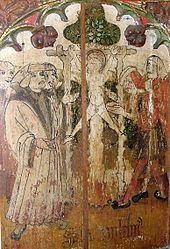William of Norwich


William of Norwich (also Saint William , born William 1132 ; died March 22, 1144 in Norwich , England ) was the alleged victim of a ritual Jewish murder . With the retold events around his death, the ritual murder legend began to develop in medieval Europe.
Legend
The 1150 from the Benedictine monk Thomas of Monmouth in Medieval Latin in the first of seven volumes wrote down history De Vita et passione sci Willelmi mart iris norwic ( "The Life and Passion of the martyr William of Norwich"), according to which was a furrier's apprentice William on Holy Wednesday, 22 March 1144 the second day of the Jewish festival of Passover , secretly murdered by Jews from the city of Norwich in a ritualized manner. The corpse was therefore moved aside by the perpetrators on Good Friday 1144 in Thorpe Wood, a forest near Norwich. After Williams' body was discovered on Holy Saturday , the suspicion fell - the chronicler Monmouth writes of a "dream face" that William's mother had seen - on the Jews of the city. Charges were brought against them, but these were dropped because the evidence presented was of no use. Both Bishop Everard of Norwich and King Stephen of England and the Norwich-based sheriff of East Anglia , John de Chesney , were not convinced of the guilt of the Jews and denied the allegations. At Easter 1150, Monmouth succeeded in tearing William's grave in the chapter house of the church from oblivion and making it an object of martyrdom. According to Monmouth's own admission, this was done in visions by the Mother of God and Saint Catherine . By the third transfer of the body, now to the Church of Norwich, in 1151, 35 miracles had already occurred after the invocation of William. The rush of admirers in 1154 led to the saint's body being reburied in the apse chapel of the north aisle. In 1158 or 1169 a chapel was built for "William the Martyr" in Thorpe Wood.
Williams' legendary life story and the history of his miracles were written down in seven books between 1150 and 1157 by the Benedictine monk Thomas von Monmouth, who himself was not in Norwich in 1144 and had to research his findings, there are no contemporary sources and no evidence on the vita. First and foremost, Thomas seemed to have wanted to create a saint for his parish in the form of William of Norwich, to propagate its cult and to benefit from the pilgrims and the income associated with them. Thomas probably also had the expectation of establishing a saint for England. In the long run, this expectation has not been fulfilled, because by the beginning of the 14th century the income from the Williams altarpiece was reduced to just 4 pence . The Thorpe Wood chapel later fell into disrepair.
The oral tradition of the martyr legend of "Saint William" recorded by Thomas von Monmouth, although not distributed in writing, ensured that the blood charge against the Jews was established across Europe.
Other medieval blood accusations
literature
- Friedrich Lotter : Innocens virgo et martyr. Thomas von Monmouth and the spread of the ritual murder legend in the high Middle Ages , in: Rainer Erb (Hrsg.): The legend of ritual murder. On the history of the blood charge against Jews , Berlin 1993, pp. 25–72, here pp. 25–48.
- Douglas Raymund Webster: St. William of Norwich . Catholic Encyclopedia 15. Robert Appleton Company, New York, 1912. From: Kevin Knight (Ed.): New Advent.org , accessed April 2, 2015.
- Augustus Jessopp , Montague Rhodes James (Ed.): The Life and Miracles of William of Norwich by Thomas Monmouth . Cambridge: University Press, 1897. Bilingual edition based on the manuscript. Scan , at Archive.org
- EM Rose: The Murder of William of Norwich: The Origins of Blood Libel in Medieval Europe , Oxford University Press 2015
- William Norwich , at Jewish Encyclopedia
- Manfred Eder : Wilhelm of Norwich. In: Biographisch-Bibliographisches Kirchenlexikon (BBKL). Volume 13, Bautz, Herzberg 1998, ISBN 3-88309-072-7 , Sp. 1255-1259.
Web links
Individual evidence
- ↑ Annotated translation and bilingual Latin-English edition: Augustus Jessopp, Montague Rhodes James (Ed.): The Life and Miracles of William of Norwich by Thomas Monmouth . Cambridge: University Press, 1897
| personal data | |
|---|---|
| SURNAME | William of Norwich |
| ALTERNATIVE NAMES | William of Norwich |
| BRIEF DESCRIPTION | alleged ritual murder victim |
| DATE OF BIRTH | 1132 |
| DATE OF DEATH | March 22, 1144 |
| Place of death | Norwich |